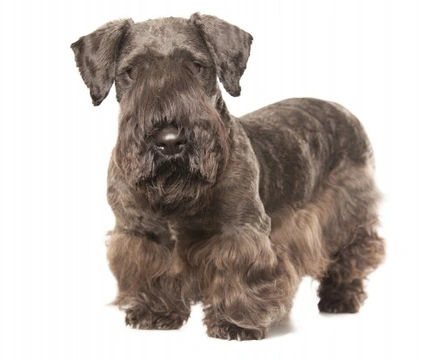
The breed standard and appearance of the Cesky terrier
The Cesky terrier is a petite dog from the terrier grouping, which hails from Czechoslovakia. They are one of the most recently recognised dog breeds, having only become recognised by The Kennel Club during the last century, and the founding dogs of the breed not being in existence in recognisable form until 1949.
The Cesky terrier is short, compact and agile, with a hardy build and tough coat to offer protection when hunting in the wild. The breed was originally used for hunting game such as duck and pheasant, and also, larger prey such as wild boar! The Cesky terrier’s appearance is very firmly delineated within the breed standard for showing, and an awful lot of different factors are taken into consideration when judging the breed in formal shows!
In this article, we will look at the breed standard and desired appearance of the Cesky terrier in more detail. Read on to learn more!
General appearance
The Cesky terrier should be short legged and well-muscled, and longer than they are tall. When shown in certain coat styles and clips, they bear some resemblance to the miniature Schnauzer, although they are not considered to be closely related and have significant subtle variations within their breed standards.
Cesky terrier coat
The coat of the Cesky should be fine and long, with a slightly textured feel to it and a glossy finish. The standard accepted grooming pattern for the breed consists of scissoring and clipping the coat so that the body has a “saddle” pattern, with longer hair leading to a “V” shape at the tail. The hair on the front of the face up to mid eyelevel is not clipped, allowing the face to have a bearded appearance, and long eyebrows. The delineation between the clipped and unclipped areas should be graduated and smooth.
The coat colour in dogs of three years or more can be seen in either grey of any shade from platinum with black pigment through to charcoal, or alternatively, may be a coffee shade of brown with liver coloured pigmentation,. The head, ears, tail and feet may have black markings too, and white, brown, grey or yellow is permitted on the limbs, chest, head and neck.
Size and build
The Cesky terrier is measured very precisely in terms of permitted height and build within the breed standard, and the guidelines are as follows:
Males should stand at 11.5” at the withers, and 10.5” for females. Variations should not range outside of 9.5” to 12.5”. The ideal weight shows some range for variation, with between 13-22lb being permissible.
The ratio of length to height should be 1.5:1, and the general appearance of the dog should be proportionate and balanced. The dog’s thoracic girth should be 17-18”.
The head and face
The Cesky terrier’s general demeanour should be kind and calm, with slightly deeply set eyes with a friendly expression. The ears are droopy and medium length, and set fairly high on the head, and triangular in shape.
The ideal dimensions of the head are 8” long by 3.5-4” wide, and wedge-shaped. The distance between the ears, and so, the width of the skull, should be slightly wider in dogs than in bitches. The muzzle should be proportionate and with a straight nasal bridge; overly narrow faces are classed as undesirable. The nose should always be black, and well formed.
The bite of the dog should be level or scissored, with thick, close-fitting lips. The teeth should be strong and straight, and set squarely in relation to the jaw.
Body and neck
The topline of the dog’s back should have a slight rise towards the tail, which should be 7-8” long, muscular and low-set. The tail may be carried either downwards, or with a slight tip up towards the end, or high and horizontal. A tail that is curled or carried over the back is considered to be undesirable.
The neck should be muscular and strong, and carried on a slant. The body should also be muscular, and oblong in shape, without high pronounced withers, but with a relatively high-set neck. The chest should not be overly deep, but rather cylindrical. The loins should be muscular and slightly rounded, as well as relatively long, and the underline should display well-filled flanks and a rounded stomach that is slightly tucked up.
Limbs and gait
The galloping gait of the Cesky should be slow and steady, with the front legs fully extended at the extent of the stride.
The angulation of the forelegs should be moderately well angulated, supported by muscular, powerful but laid back shoulders, and loose elbows. The forelegs should be parallel, well boned, short and straight, and may or may not display dewclaws.
The hindquarters should be well angulated, with strong, well-muscled and parallel legs. The upper thigh too should be well muscled, with well developed, high-set hock joints.
The feet of all four legs should have strong nails, and thick, well developed pads, with the forefeet slightly larger than the hind feet, and all four limbs requiring well-arched toes.



